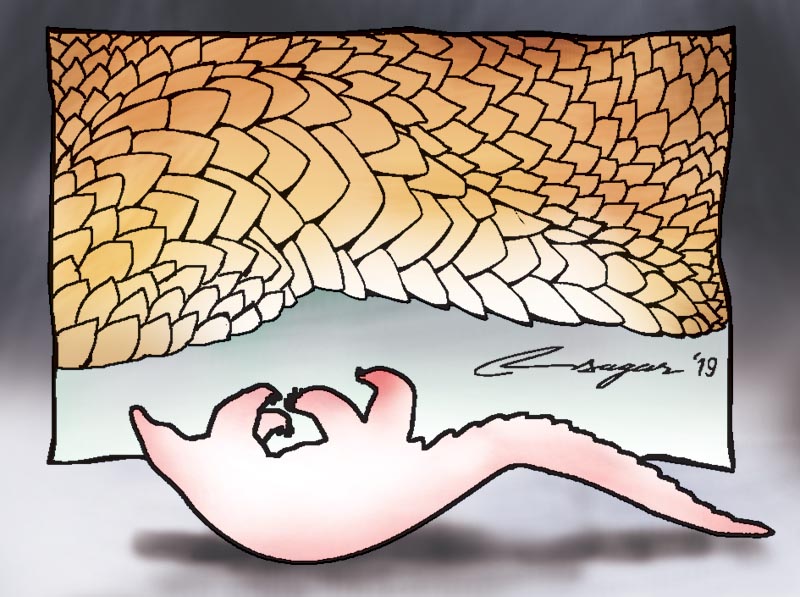Pangolin: The most trafficked mammal
Pangolins play an important role in the ecosystem. They are regarded as a natural pest controller as a single pangolin will eat up to 70 million insects annually. Local awareness is a must so that the communities are fully aware of its benefits
Many of us were busy sharing love on February 14, that is, Valentine’s Day, but who knew what February 16 was for? World Pangolin Day is celebrated on the third Saturday of February, and this year, the 8th World Pangolin Day fell on February 16. The day was meant to raise awareness about its growing illegal trade and save the endangered animal from extinction.
The pangolin is the only mammal to be covered with scales. It is shy, elusive, nocturnal and insectivorous, and is a peculiar creature as big as a domestic cat or dog. It mostly feeds on ants and termites, using its long sticky tongue, so is commonly called a “scaly anteater”. It is well adapted for digging whereas some African species are good climbers, too.
The name “pangolin” is derived from the Malay word “pengguling”, which means “something that rolls up”. So, when it is threatened, a pangolin will curl itself into a tight ball, and can defend itself from predators, but this makes it easy for the poachers to pick it and put into a sack.
There are eight species of pangolins - four Asian and four African. The Asian ones are commonly found in Nepal, China, India, and south-east Asia. They are commonly known as “Salak” in Nepali. Among these four Asian species, the Chinese pangolin (Manispentadactyla) and Indian pangolin (Maniscrassicaudata) are found in Nepal. A recent national survey reported the presence of pangolins in 43 districts of Nepal. Kavrepalanchok, Sindhupalchok, Dolakha, Sindhuli and Ramechhap districts are the prime habitats of the Chinese species whereas Parsa, Chitwan, Makwanpur and Kanchanpur are home to the Indian ones.
It’s a pity that more than 20 per cent of all illegal wildlife trade comprises the pangolin. Trade in the pangolin is sky high in comparison to the elephant, rhino and other high-profile species. TRAFFIC, the wildlife trade monitoring network, estimates 200 tigers and 1000 African rhinos are poached yearly. But the number of pangolins poached is 50 times the number of tigers and 10 times that of the African rhino.
Overall, more than 1000,000 pangolins are believed to have been poached from the wild in the past decade, making them the most-trafficked wild mammal on the planet. The main markets for the frozen pangolins and their dry scales are China and Vietnam. They mostly find their way to these two countries through Indonesia in shipping containers.
Nepal has become the South Asian hub for the trade in pangolins. Most of the animals and their parts are supplied to China through the border with Tibet. The pangolin trade has fostered in Nepal because of the unregulated border with India. In 2013, around 325 kilos of pangolins scales, which were gotten from roughly 1,300 individuals, were seized on the Kathmandu-Kodari Highway alone.
According to conservation officer Ambika Khatiwada, records show that more than 784 kilos of pangolin scales have so far been seized in Nepal. This is just the tip of the iceberg of the pangolin trade. With increase in international trade in pangolin scales, Nepal’s pangolins are also under massive threat.
China is the largest consumer of pangolin scales. They are used in traditional Chinese medicine where the scales are believed to cure illnesses, heart diseases, cancer and female reproductive disorders. The fresh blood of a pangolin is said to be an aphrodisiac. But there is no scientific evidence to show that they are a cure for these diseases. Pangolin scales are made from a protein called “keratin”, the same protein that our nails and hairs are made of. Unfortunately, these myths are taking the innocent pangolin to the brink of extinction.
Pangolin meat is considered a delicacy and is in high demand in many restaurants in both China and Vietnam. Its meat is often served as the most expensive item on the restaurant menu.
The pangolin mostly prefers agricultural land near human settlements rather than a forest area. Hence, most pangolin habitats fall outside the protected area. The pangolins are active during the night time and live by digging holes. Poachers are no other than the locals who hunt these innocent species for the sake of good money.
All the species of the pangolin are listed in the IUCN (International Union for Conservation of Nature) Red List of Threatened species. The Government of Nepal has listed both pangolin species in schedule I of the National Parks and Wildlife Conservation (NPWC) Act 1973.
Despite efforts by both the government and many international organisations to curb the illegal trade of these species, the outcome has not been very encouraging. As a consequence, pangolins are shrinking at a rapid rate, and they are believed to become extinct from many villages in Nepal. Pangolins play an important role in the ecosystem. They are regarded as a natural pest controller as a single pangolin will eat up to 70 million insects annually. Local awareness is a must so that the communities are fully aware of its benefits.
Due to its shy and nocturnal nature, it is difficult to do research on them, and so there is limited knowledge about them. Therefore, really good conservation efforts are needed, and for that effective anti-poaching law enforcement must be put in place nationally and internationally to save these endangered species from extinction.






